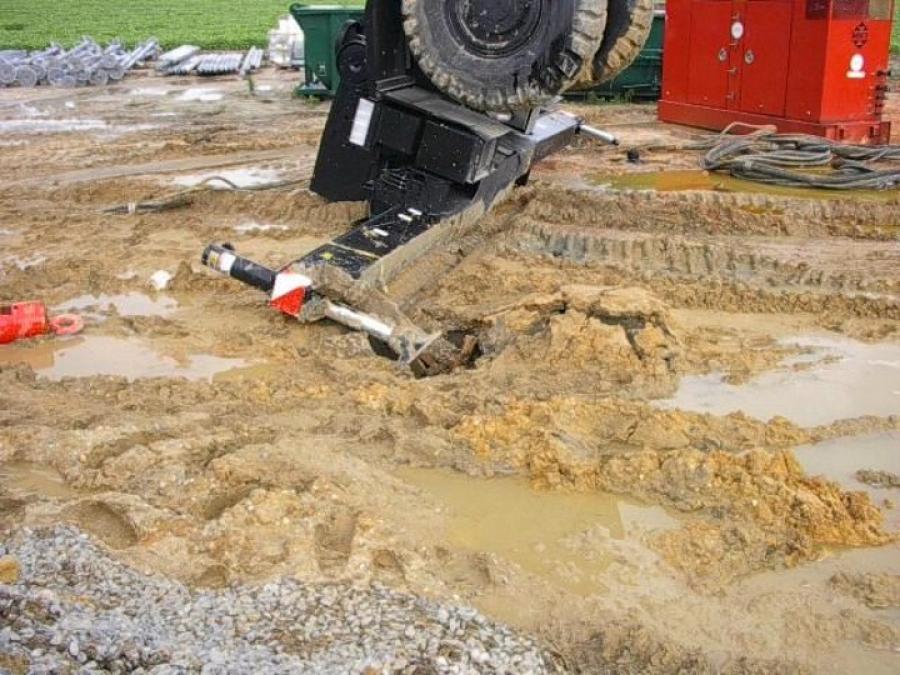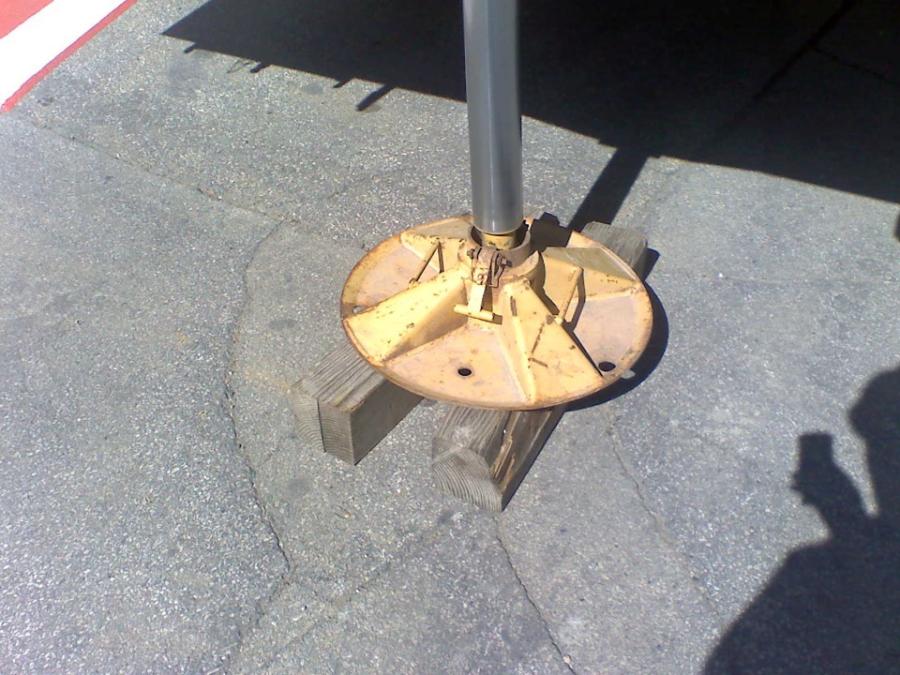Hydraulic fluid leakage and poor ground support are two of the most-critical contributors to outrigger failure and crane tip overs. Regular inspections can alleviate leakages; a geotechnical expert can determine ground conditions.
(RHTC Inc. photo)
The two biggest factors that contribute to crane failures are fluid leakage in the outrigger hydraulic cylinder and ground conditions, or the supporting structure for the outrigger pads. Ensuring that your crane is operating on firm, level and drained ground per OSHA's Cranes & Derricks in Construction rule, starts with a proper inspection of the crane and the job site.
"One safety device talked about in OSHA Subpart CC section 1415 is the integral holding valves in your crane," said Joe Kuzar, technical director of Woodland, Wash.-based Industrial Training International (ITI). "OSHA deemed them to be safety devices. If a hose ruptures, the valves make sure the fluid in the hydraulic cylinder doesn't evacuate and the crane stays upright."
"Hydraulic leaks are spoken to in section 1412 of Subpart CC, under shift inspections," he added. "Shift inspections are required of the operator to make sure the crane is in proper working order. These leaks do not go away, and though they get reported on an inspection sheet, they often don't warrant the attention they should."
CJ Wilson, a trainer with RHTC Inc., West Monroe, La.,. said visible seepage around the outrigger jack cylinders must be addressed because when it occurs, there's no guarantee the outrigger will support the crane. The engineering and design of the crane are such that each outrigger has to support 100 percent of the weight of the crane plus the weight of the load.
"If you swing the load over the outrigger, that outrigger is supporting everything," he said. "When you have outriggers with seepage, you're not holding fluid in the cylinder and that gets to be a problem. A hydraulic hose may bust, but as long as the block valves on the cylinder are working, you're OK.
"There's nothing to indicate seepage, other than the operator having to adjust the outrigger jack constantly," he added. "If you're constantly having to adjust it, the block valve is not working properly, and that's a safety issue, per OSHA. The crane has to be shut down immediately and repaired."
On the Level
Ground conditions are the second most-critical issue when it comes to preventing outrigger failures. In Section 1402 of OSHA's Cranes & Derricks Rule Small Entity Compliance Guide, the importance of ground conditions is emphasized: "Adequate ground conditions are essential for safe crane operations because the crane's capacity and stability depend on such conditions being present. If, for example, the ground is muddy or otherwise unstable, a crane could overturn even if operated with the load limits specified by the manufacturer."
OSHA's basic rule concerning ground conditions states that a crane must not be assembled or used "unless ground conditions are firm, drained and graded to a sufficient extent so that, in conjunction (if necessary) with the use of supporting materials (such as blocking, mats or cribbing), the equipment manufacturer's specifications for adequate support and degree of level of the equipment are met."
An operator must ensure his crane is set up on firm, supporting ground that is as level as it can be. "Do your due diligence," stressed Kuzar. He said many rules-of-thumb traditionally used in the crane industry to determine ground-bearing pressures are considered archaic by today's standards. The old rule that if you take the gross capacity of the machine and divide it by five, you get the square footage for each outrigger pad "doesn't take in to account the ground conditions which need to be addressed. "Our machines are much more sophisticated now," he added.
Wilson believes ground conditions and the blocking chosen for use under the outrigger pads are a bigger issue than properly working outrigger jack cylinders. Cranes, he said, are designed based on perfect conditions, but perfect conditions do not exist in the real world.
"We have to ensure the outrigger pad contacts the ground over as large an area as possible based on ground conditions," he said.
For instance, in a rocky area, the ground is very compact and solid, so an abundance of support under the pad is not necessary. But on soft, muddy ground, the support is usually lacking, and the thickness of two or three pads is needed for the crane to remain level.
"With most outriggers, one percent of level is ideal, but we cannot achieve that," Wilson said. "We've got to use blocking — a hardwood pad bolted together with no gaps is OSHA's preferred method — as long as we're keeping tight, closed contact with the existing pad of the crane."
And, the blocking chosen depends on the ground conditions, he said.
"What's dictated to us by law is the ground be firm, level and drained. It's not firm all the time and that's a common problem that has to be addressed with mats, in multiple layers sometimes."
Many times, crews lay pads and a support structure on ground that's unlevel, which creates a weak condition for the outrigger jack shaft. It puts stress not only on the jack shaft but the outrigger beams as well, he said.
Size Matters
Confirming ground conditions, under OSHA's Subpart CC, is the responsibility of the job site controlling entity, which can be the site owner or general contractor.
"When we go on sites, most of the time my crane supervisor is there before the job ever begins and we have the pad built," Wilson said. "If the ground is not level, we have to get it level to use the crane that day."
Proper mat sizing and condition are another key to preventing outrigger failure. The right mat must be sized not just for the crane, but for ground conditions. A crane exerts bearing pressure on the ground, and the bearing capacity of the soil is where the ball often gets dropped, said Kuzar.
"We're getting better at recognizing the need to determine ground bearing pressures, but we're not always seeing the value of a geotechnical specialist to evaluate the soil and bearing capacity," he added.
If the mat is sized at less than it needs to be to support ground-bearing pressure, the crane can sink. Kuzar believes the industry most often drops the ball where small cranes are concerned.
"Smaller cranes, such as light boom trucks and small hydraulic mobile cranes, don't catch the eye. Yet, those cranes can go over just as easily as large cranes because of poor ground conditions. That's the audience we need to reach, the smaller crane operator catching two or three jobs a day maybe for a rental company where the quality of the cribbing may not be that good, or the matting may not be the size it needs to be."
Bo Collier, president of Brandon, Fla.-based Crane Tech, said instructors spend quite a bit of time in training classes on the subject of ground-bearing pressure.
"We find the cribbing used under a lot of outrigger pads is very inadequate," he said. "In general, people don't give it a lot of consideration, and they don't understand what they're attempting to do. If you put down 2 x 4 blocking and think you've added stability, you really haven't done anything at all to support the outriggers."
Manufacturers figured out over the years it's smarter to build an outrigger pad that is adequate as long as the ground is adequate, said Collier.
"They know you need more area to spread the pressure out. Crews fail to anticipate the maximum pressure a crane would exert per square inch — and the crane sinks in the soil as a result."
Think Outside the Box
Wilson notes one other outrigger failure prevention issue, … this one in older cranes: Sometimes the wear pads and slide areas on the outrigger box beams get overlooked. Corrosion sets in, and once a slack is created, stress points result. An issue in aging cranes, it tends not to get as much attention as, say, hoist ropes, and swing bearings, he said, adding that box beams in general seem not to be as well taken care of in many instances.
"The box and beams are reinforced to handle the load at exact positions," said Collier. "People set cranes up with outriggers not where the boxes and beams are reinforced and the outrigger beams go through the bottom of the boxes because of where the force is. It's not necessarily an issue with the buckling of the outrigger beam, but the bottom of the box needing to be reinforced."
Collier urges crane operators to spot-check the crane setup and make sure they're aware of structural limitations. Check the crane manual carefully and setup correctly for maximum safety, he said, and if you have questions, contact the supplier or manufacturer for clarification of outrigger positioning.
"Take the time to do it right the first time," he said, "because no one wants to see their crane tipped with a broken outrigger." CQ
This story also appears on Crane Equipment Guide.
Lucy Perry
Lucy Perry has 30 years of experience covering the U.S. construction industry. She has served as Editor of paving and lifting magazines, and has created content for many national and international construction trade publications. A native of Baton Rouge, Louisiana, she has a Journalism degree from Louisiana State University, and is an avid fan of all LSU sports. She resides in Kansas City, Missouri, with her husband, who has turned her into a major fan of the NFL Kansas City Chiefs. When she's not chasing after Lucy, their dachshund, Lucy likes to create mixed-media art.
Read more from Lucy Perry here.
Today's top stories
















